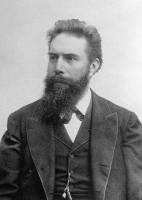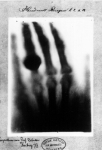The ray was capable of passing through most substances and casting shadows of solid objects on pieces of film. Two weeks after his discovery, Roentgen produced one of the earliest photographic plates from his experiments. The film was of his wife, Bertha’s hand with her wedding ring clearly visible on her finger (image shown below), was produced on Friday, November 8, 1895. Roentgen found that the X-ray would pass through human tissue and leave a visible shadow of the bones and metals.
The news of Roentgen’s discovery spread quickly throughout the world. The cathode tube was well known during the late 1890’s which allowed scientists around the world to duplicate his experiment. By February 1896, X-rays were finding their first clinical use in the US in Dartmouth, Massachusetts, when Edwin Brant Frost produced a plate of a patients colles’ fracture for his brother, a local doctor. Scientists quickly realized the benefits of X-rays but were not initially aware of the harmful effects of radiation exposure.For several years after the discovery of the X-ray it was believed that the rays passed through flesh as harmlessly as light. This common belief began to fade as reported cases of burns and skin damage after x-ray exposure started to increase. In 1904, Thomas Edison’s assistant, Clarence Dally, who had worked with X-rays, died of skin cancer. Dally’s death caused some scientists to take notice of the potential risks associated with radiation exposure, although not fully understood. Roentgen died on February 10, 1923 from carcinoma of the intestine. His death was not attributed to his work with ionizing radiation because of the brief time he spent on those investigations and because he was one of the few pioneers in the field to routinely wear protective lead shields.
In 1901, Roentgen was awarded the first Nobel Prize in physics. Roentgen refused to take patents for his discoveries, as he believed that all mankind should benefit from his discoveries. His discovery of the X-ray revolutionized the modern practice of medicine in ways that he could never imagined. Today, Roentgen is considered the father of diagnostic radiology, the medical speciality which uses imaging to diagnose diseases.
The 8th of November is also celebrated by radiographers worldwide as World Radiography Day to commemorate Wilhelm Roentgen’s Discovery of X-rays. The purpose of this day is to raise awareness of radiographic imaging and therapy, which play a crucial role in the diagnosis and treatment of patients and, most importantly, ensuring radiation is kept to a minimum required which ultimately improves patient care.


Leave a Reply